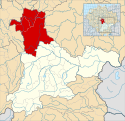Markrabství Nordgau
| Markrabství Nordgau Markgrafschaft Nordgau
| ||||||||||
geografie
| ||||||||||
| obyvatelstvo | ||||||||||
| státní útvar | ||||||||||
vznik: | kolem roku 806 | |||||||||
zánik: | ||||||||||
| státní útvary a území | ||||||||||
| ||||||||||
Markrabství Nordgau (německy Markgrafschaft Nordgau) neboli Bavorské Nordgau (německy Bayerischer Nordgau) byl středověký pohraniční administrativní celek Bavorského vévodství ve Svaté říši řimské, jehož sousedem bylo České království a z něhož se později vydělilo Chebsko, které bylo připojeno k Čechám. Zbytek se přeměnil na Bamberské knížecí biskupství a Horní Falc. Hlavním městem byl Mnichov.
Reference
Média použitá na této stránce
Autor: Alphathon /ˈæɫfə.θɒn/ (talk), Licence: CC BY-SA 4.0
A map of the March/Margraviate of (the) Nordgau (German: Markgrafschaft Nordgau) within the Duchy of Bavaria around the year 1000.
The map is derived from a vectorised version of one found in Professor G. Droysens Allgemeiner Historischer Handatlas, which was published in 1886 by R. Andrée Plate, and is now in the public domain.
Note that while it uses the same scheme as standard location/locator maps, this map technically does not conform to the standard, as it is not in equirectangular projection. Therefore grid lines for latitude and longitude are also included on the sub-map.Coat of arms of Bamberg
Autor: Sir Iain, lion and crown by User:Sodacan, Licence: CC BY-SA 3.0
Arms of the Palatinate, without the Bavarian quarter.
Znak města Cheb. Znak má tuto podobu: tvoří jej dělený štít, v jehož dolní červené polovině je pětinásobná stříbrná mříž se šikmými a kosmými tyčemi. V horní zlaté polovině vyrůstá z dělicí linky černá orlice s roztaženými křídly a hlavou otočenou heraldicky vpravo, tj. z čelního pohledu vlevo, mající zlatý zobák a červený vyplazený jazyk.
Autor: Vlastní dílo, Ronald Preuss (eagle), Licence: CC BY-SA 4.0
Royal banner (Königsbanner) of the German kings and emperors in the early to mid 14th century. The upright rectangular shape of the field approximates the proportions of 14th-century military banners, see e.g. File:Codex Balduini Trevirensis - Alpenüberquerung Heinrich VII.JPG





